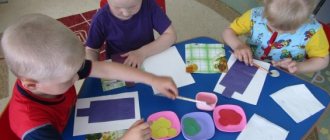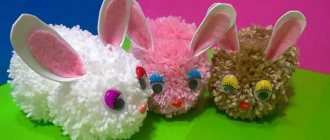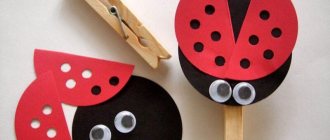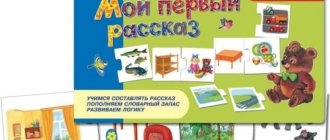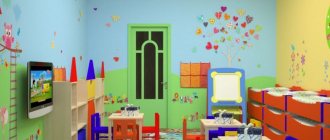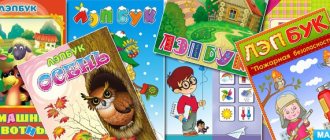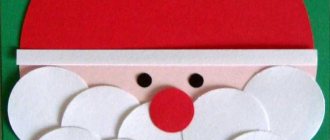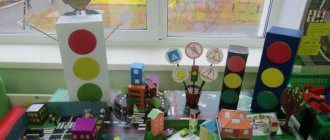Article:
To increase the effectiveness of speech correction classes for children, it is necessary to widely use speech therapy games.
This especially applies to classes with preschool children, because their main activity is play. Through speech therapy games for preschoolers, speech sounds in syllables and words are automated, and the ability to coherently express their thoughts is developed. Educational speech games for preschool children can be purchased in printed form. But many speech therapists use homemade games in their classes. Parents can also benefit from this experience.
Speech therapy games to reinforce correct pronunciation
In their classes, speech therapists use the following homemade games:
- “Release the balloons” to reinforce the correct pronunciation of the sound S. The painted balloons of different colors represent syllables with this sound. The child selects balls and pronounces forward and backward syllables. You can also stick images of objects with the sound C on the balls.
- "Autumn leaf fall." We hear the sound Ш when we sweep fallen leaves with a homemade miniature broom. On the paths drawn on cardboard there are yellow, red, brown leaves. The child imitates sweeping leaves by making a sound. Then we move on to sweeping paths with syllables and words starting with Sh.
- "Play, accordion." You can consolidate sounds in words using a homemade accordion with object pictures pasted onto any sound that was assigned to the child and which needs to be consolidated in the preschooler’s speech.
- "Magic Tree" The speech therapist draws a tree with leaves or fruits on which syllables are written or objects are depicted in the sound required for automation.
- “We are going to distant lands.” The locomotive is carrying carriages - we fix the sound Ch. Animals are riding in the carriages. By naming them, the child reinforces the correct pronunciation of the assigned sound and the composition of small sentences.
Do-it-yourself speech therapy manual for kindergarten. Master class with photos
Master class on making a speech therapy manual “The Magic Firefly”
Author: Fomina Dina Andreevna, speech therapist teacher, structural unit of the State Budgetary Educational Institution of Secondary Educational Institutions in the village of Maslennikovo. Goal: Differentiation of sounds in words, development of phonemic perception.
Children really like this manual and do not get bored of it at all. It will help not only differentiate sounds, but also develop the child’s skills of self-analysis and self-esteem, which is especially important when the Federal State Educational Standard is introduced into the education system. The idea is certainly not new, there are many manufacturing options, but I haven’t found such master classes. I will share with you my option. Equipment, material: • A piece of fiberglass, slightly larger than an A4 sheet.
• Wooden blocks for the frame. • Water with added ferric chloride. • Indicator screwdriver. • Laminator/tape. • Nail polish. • Nail polish remover. Step-by-step process for making a game
Step 1. To mark the locations for the holes in the manual, you can either prepare templates with pictures on sheets in advance, and then mark them on the PCB. Or make marks directly on the PCB, and then adjust the templates to them. So, we outline the heels that will need to be hit with wiring. We make them large in advance so that we can hit them accurately. We lead a path to each heel (the paths can be quite thin). There can be any number of such paths with branch patches. I have 2 of them. The main thing is that they do not intersect.
Step 2. Paint over these paths with varnish.
Step 3. Wait for the varnish to dry. Then we place the textolite in water and add ferric chloride in a ratio of 1:3. In this solution, the board is etched, and only the areas painted over with varnish remain - our tracks. Small boards are etched quickly, but such a large piece took half a day on each side, since the entire plate did not fit into the bucket. I also connected two wires from the power supply to the textolite board. This is just to speed up the process! You can do without this and just leave the board in the water overnight!
Step 4. Remove the varnish with a solvent.
This is what happens. Front and back view:
Step 5. Install the frames so that they can hold the templates with drawings. Instead, you can use adhesive photo corners or attach templates using rubber bands or clothespins or clips.
Step 6. We make templates with pictures for the task we need (finding a picture with a given sound, wild/domestic animals, words with a certain number of syllables, etc., etc.). Laminated for strength and durability. We cut holes in the templates in those places where there are heels on the PCB. Step 7. Cover the back of the book with beautiful paper for aesthetics.
Step 8. Insert templates into the manual.
For this tutorial I use an indicator screwdriver. It can be purchased at construction stores.
We place one finger on the symbol of the sound we are looking for. We place the second finger on the screwdriver. We look for a picture whose title contains this sound, and place the tip of a screwdriver in the hole under this picture. If the word actually has the target sound, the light will light up. You can make something similar to a screwdriver yourself. For example, use not your own body as a conductor, but a wire with two tips. On the wiring there is a light bulb or LED and a battery for it. The mechanism will light up when the circuit is closed. Everything will look aesthetically pleasing if the mechanism is placed in a pen or felt-tip pen. READY!
The manual is convenient due to its versatility. Templates can be very different. There are several spots on the textolite; you can use different contact points for each new template so that the child does not remember their constant position. The manual can also be used while studying the topic of electricity and electrical devices. I made it for work on differentiation and automation of sounds, but it will also be used for other purposes, for example, for differentiating general concepts (wild/domestic animals, etc.). For older children, you can explain the mechanism of operation and talk about electricity. For younger children, we organize a game story. For example, a game with a magic firefly. Instructions for the game plot: “There is a magic firefly in this wand. One night he dropped his pictures. Now the firefly can't find where his pictures are. Help him. Find only those pictures that have a sound in their title […]. To check if you are thinking correctly, place one finger on the sound symbol […] and the other on the stick with the firefly. Now place the stick in the hole next to the picture you chose. If this is a picture with a sound in the title […], then the firefly will be happy and light up. Check the rest of the pictures as well.” The master class may seem difficult for you, dear ladies, due to the use of unusual materials. But everything is much simpler than it seems. Try it and see. All necessary materials can be purchased at an electrical or radio store. Thank you for your attention!
We recommend watching:
Didactic game for preschoolers to develop fine motor skills Do-it-yourself didactic game for kindergarten Do-it-yourself houses made from plastic bottles Speech therapy manual “Who lives where?” DIY felt for kindergarten
Similar articles:
Do-it-yourself didactic games made from waste material
Do-it-yourself didactic game for preschoolers “In the world of animals”
Do-it-yourself didactic game for kindergarten on the topic “Sports”
Games for distinguishing sounds in words
Do-it-yourself speech therapy games for preschoolers help teach children to distinguish sounds by ear, develop their attention, and expand their vocabulary.
- "Funny transformations of words." The famous poem by A. Shibaev “The Letter Got Lost” is well suited for this game:
They say one fisherman
I caught a shoe in the river,
But then he
A crowbar caught the hook!
It is necessary to find the word that is lost and replace it with the appropriate one. Humorous drawings are also prepared for these quatrains.
- "Score a goal." Football goals are drawn on paper, the bars represent the letters M and L. In the images of footballs, the vowels I, Y, O, E, I, A. We score a goal and form the words: mil, soap, mole, chalk, crumpled, small. You can play the game by reading these words:
- If you use a barbell to make an M, if you use a barbell to make an L, and score an I into the goal, it will be... The child names the resulting word. So all the letter-balls fall into the goal.
- "Rebus". Solving puzzles develops a child's logic, thinking and speech. You can draw the puzzles yourself by encoding in them any word or tongue twister that uses the sound assigned to the child.
- "Replacement of sound." The speech therapist has a picture with a drawn object, he asks to replace the initial sound in the word. Barrel - daughter, point, hummock, night. You can replace sounds in other parts of the word. Goat - leather, bark, braid.
- "The Hidden Word" Show subject pictures. The child names what is shown. In every word there is another one that is hidden from us. The speech therapist asks: “Can you find the word that is hidden?” A duck is a dot, a scythe is a wasp, a shelf is a floor, a pillar is a table, a wolf is an ox.
- Lotto and Domino games can be made together with children. Select and paste subject pictures onto cardboard. The preschooler pronounces the names of the objects shown on the cards.
These do-it-yourself speech therapy games are used to develop the ability to generalize, analyze, and teach you to be attentive.
A set of original speech therapy games “Chamomile Stories”
A set of original speech therapy games “Chamomile Stories” is intended for use in correctional and speech therapy work with children of senior preschool age and is compiled in accordance with the requirements of the federal state educational standard for preschool education, as well as taking into account the age and individual characteristics of preschoolers. A set of original speech therapy games “Chamomile Stories” is intended for use in correctional and speech therapy work with children of senior preschool age and is compiled in accordance with the requirements of the federal state educational standard for preschool education, as well as taking into account the age and individual characteristics of preschoolers.
The manual allows you to comprehensively solve problems in all educational areas: social and communicative development; cognitive development; speech development; artistic and aesthetic development; physical development. Allows you to intensify pedagogical activities aimed at timely and most effectively overcoming speech disorders in children.
Goal: Correction of speech disorders in older preschoolers through game material aimed at developing a respectful attitude and a sense of belonging to one’s family, instilling in children a sense of love and respect for their parents and their native land.
Objectives of the priority educational area “Speech development”
- enrichment of the active vocabulary;
- development of coherent, grammatically correct dialogical and monologue speech;
- development of the sound culture of speech, through the automation of sounds (S, Z, Sh, Zh, R, L), their differentiation, improvement of phonemic hearing;
- listening comprehension of texts from various genres of children's literature;
- formation of sound analytical-synthetic activity as a prerequisite for learning to read and write.
Educational objectives in the integration of educational areas:
"Social and communicative development"
- developing a respectful attitude and a sense of belonging to one’s family.
- introducing children to the customs and traditions of celebrating the holiday “Day of Family, Love and Fidelity”
"Cognitive Development"
- develop cognitive activity, curiosity, and creative thinking of children through familiarization with the history and traditions of the Orthodox holiday “Day of Family, Love and Fidelity”;
- formation of cognitive actions, formation of consciousness; development of imagination and creative activity;
"Physical development"
- improve fine motor skills
The form of organizing children's activities is speech therapy subgroup correctional and developmental games.
The set includes 6 speech therapy games:
- "Daisies for Natasha"
- "Gather the Family"
- "Speech therapy chamomile"
- "Who? Where?",
- "Pure talk"
- Illustrations for the text “Peter and Fevronia”.
"Daisies for Natasha"
Goal: automation of the sound [Ш] in words with different positions, improvement of phonemic hearing, enrichment of the active vocabulary, development of fine motor skills.
Equipment: one A4 playing field, 24 cards with daisies.
Vocabulary material:
- sound [Ш] at the beginning of a word: hat, shampoo, chocolate, fur coat, wardrobe, bumblebee, helmet, washer, box, jester, shorts, hat;
- sound [Ш] at the end of a word: shower, pencil, reed, lily of the valley, baby, mouse;
- sound [Ш] in the middle of a word: cat, frog, parsley, cone, horse, car.
Progress of the game
First option: The speech therapist invites the children to help the boy Misha collect a bouquet of daisies for Natasha. Children take daisies one by one and name the pictures drawn on them, clearly pronouncing the sound [Ш].
Second option: The speech therapist invites the children to help the boy Misha collect only those daisies for Natasha whose name contains the sound [Ш] at the beginning of the word (middle, end). Children take daisies one by one and name the pictures drawn on them, clearly pronouncing the sound [Ш], determine the place of the sound [Ш] in the word.
"Gather the Family"
Goal: automation of sounds [R, L] in words, differentiation of sounds [R - L], improvement of phonemic hearing, enrichment of active vocabulary, formation of a respectful attitude and a sense of belonging to one’s family, development of fine motor skills.
Equipment: one A4 playing field, 18 cards with boys and girls.
Vocabulary material:
- sound [R]: rainbow, daisy, fish, rose, rocket, hand, shell, dew, lynx;
- sound [L]: swallow, puddle, boat, spoon, horse, bow, lily of the valley, moon, bast shoes.
Progress of the game
The speech therapist offers children to help parents find their children. Preschoolers take turns taking cards with boys and girls, calling out the pictures on their costumes, clearly pronouncing the sounds [R - L]. They lay out the cards, correlating the sound in the word with the letter drawn on the tower.
"Speech therapy chamomile"
Goal: development of sound culture of speech, through the automation of sounds (S, Z, Sh, Zh, R, L), their differentiation, improvement of phonemic hearing; enrichment of active vocabulary, formation of cognitive actions, development of fine motor skills.
Equipment: 42 petals, each of which has pictures of objects whose names contain a sound. Six yellow circles with the letters: C,Z,SH,ZH,L,R
Progress of the game
Speech therapist:
Look from the window, There is a chamomile, a drop of sun. Collect petals - sound, try, name it!
A speech therapist distributes petals to playing children.
Children name the picture on their petal, determine whether the given sound is in the word and insert it into the corresponding core. After the daisies are collected, the speech therapist praises the children and asks them to repeat all the words in chorus: “Well done, but you still need to repeat the pictures together.”
Children name the pictures on each daisy, clearly pronouncing the sounds.
Vocabulary material:
- sound [R]: rainbow, fish, rose, rocket, shell, dew;
- sound [L]: swallow, puddle, boat, lily of the valley, moon, palms.
- sound [Ш]: hat, chocolate, chaise longue, shorts, box, flip flops.
- sound [Zh]: beetle, giraffe, acorns, jasmine, toad, vest.
- sound [S]: catfish, juice, sandals, salad, airplane, gardener.
- sound [Z]: hare, umbrella, sunset, castle, tan, tooth.
"Who? Where?"
Goal: development of coherent, grammatically correct dialogical speech; developing the ability to correctly use prepositions, enriching an active vocabulary, developing a respectful attitude and a sense of belonging to one’s family, and developing fine motor skills.
Equipment: one A4 playing field
Vocabulary material : grandfather, grandmother, father, mother, daughter.
Progress of the game
The speech therapist asks the children to name those who are drawn in the picture.
First option: The speech therapist asks the children questions, and preschoolers must answer with a detailed answer.
Who's sitting on the bed?
Who is behind the chair?
Who's at the table?
Who is sitting on the chair?
Who stands between the chair and the bed?
Who is standing in front of the stove?
Second option: The speech therapist asks the children to name where grandfather, grandmother, mother, father, daughter, cat are located.
"Pure talk"
Goal: teaching children to clearly pronounce the given sounds [Ш, С, З, Р, Л] in phrasal speech, at a fast pace.
Equipment: 16 cards with pure sayings and illustrations for them.
A clean talker is a funny short poem, the purpose of which is the deliberate selection of words that are difficult for correct articulation when repeated quickly and repeatedly. Pure speech is also used as a means to correct speech defects in children.
Options for using pure phrases:
- pronouncing pure phrases in turn or in chorus, collectively;
- pronouncing pure phrases with different emotional tones of the voice;
- pronouncing pure sayings on behalf of fairy-tale characters (Karabas Barabas, Pinocchio, etc.);
- pronouncing pure sayings using the ball (simultaneously hitting the floor);
- pronouncing simple sayings using a massage ball.
Illustrations for the text “Peter and Fevronia”
Goal: enrichment of the active vocabulary; development of coherent, grammatically correct dialogical and monologue speech; developing the ability to understand texts from various genres of children's literature by ear; introducing children to the customs and traditions of celebrating the holiday “Day of Family, Love and Fidelity”; develop cognitive activity, curiosity, and creative thinking of children through familiarization with the history and traditions of the Orthodox holiday “Day of Family, Love and Fidelity”; formation of cognitive actions, formation of consciousness; development of imagination and creative activity.
Equipment: 5 A4 illustrations for the text “Peter and Fevronia”.
Progress of the game
The speech therapist invites the children to listen to the story and try to remember it.
In the glorious city of Murom lived and lived Prince Pavel. And he had a brother, his name was Peter. Pavel was in trouble. A snake began to fly to his wife. She complained to her husband, and Paul asked her to find out from the serpent the secret of his death. And the snake said that he was destined to die “from Peter’s shoulder and from his sword.” And Peter decided to help his brother - to destroy the damned serpent. He swung his sword and struck the adversary. But the serpent splashed Peter with its poisonous blood, and Peter’s body was covered with sores. No one could heal Peter from a serious illness. Peter humbled himself and prepared to die. But the Lord advised him: they say, there is a young girl in the Ryazan lands who can heal him.
The prince's servants found a girl named Fevronia. And she said that she could heal the prince, and did not ask for anything as a reward, but after his recovery, the prince must take her as his wife, otherwise the treatment would not work. The prince agreed. And after his healing he took Fevronia as his wife.
They lived happily ever after in love and harmony. And they died on the same day and hour. The holy spouses were buried together near the cathedral church of the Nativity of the Blessed Virgin Mary, and every believer received generous healing here.
So says the legend.
After reading, asks questions:
- In what city did Paul reign?
- What was his brother's name?
- Who flew to Pavel's wife?
- With what help did Peter deal with the serpent?
- What happened to Peter?
- How was Peter healed?
- What was the name of the girl who healed Peter?
After this, he gives the task to arrange the illustrations for the text in order. And then asks to retell the text based on them.
Theatrical play activity of children during classes with a speech therapist
Speech therapy classes for children are not complete without the use of elements of theatrical play activities for preschoolers. You can make figurines for the theater yourself. This could be a finger theater. Masks of fairy-tale characters are made from paper, they are put on the finger, and the performance is performed. In the tabletop theater, fairy-tale characters made of cardboard are inserted into spools of thread. The shadow theater is also interesting. It requires a small white backlit screen and black action figures.
You and your children can come up with your own unusual fairy tales, where the heroes can be vegetables, fruits, and household items. Small theatrical performances bring joy, develop children’s imagination, strengthen memory, and make speech varied and correct.
Speech therapy games for children play a major role in the development of correct pronunciation in preschoolers.
